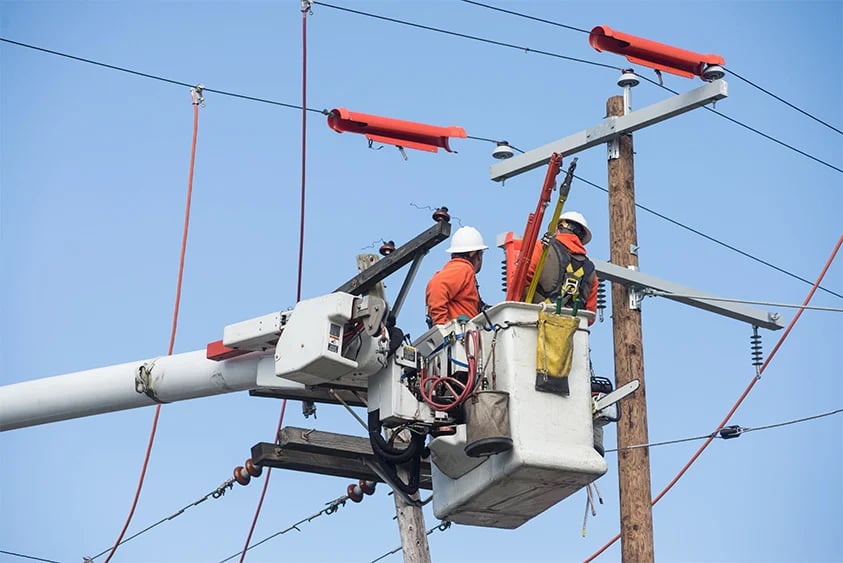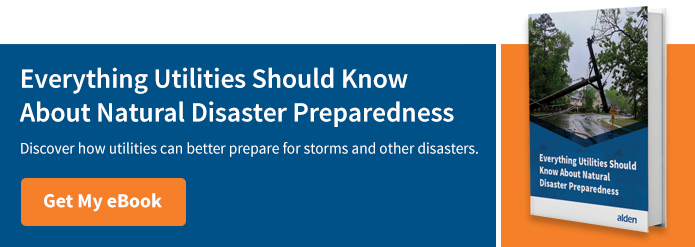Storm Hardening 101: What Utilities Should Consider and Why

Utility professionals have always been at war with the weather. Disruptive storms, whether in the form of hurricanes, tornadoes, ice storms, or flash floods, have posed a continual threat to utility infrastructure.
In recent years, the overall intensity, frequency, and cost of extreme weather events greatly increased, as noted by Utility Dive. Among others, Superstorm Sandy in 2012 and a series of major hurricanes including Irma, Maria, and Michael in 2017 and 2018 interrupted electric service to millions of customers and took a toll on utility plants.
A 2016 report from the U.S. Department of Energy predicted more of the same: “Electricity reliability is increasingly put at risk by climate change and extreme weather events that can exceed the design parameters and other limits of power system assets and operations.”
The report urged “appropriate and proactive planning and investment” to “reduce our energy infrastructure’s critical vulnerabilities to climate and extreme weather.”
Some utilities have made major investments in recent years, and others are considering which steps to take.
Better severe weather preparedness could mean more streamlined, more detailed, better-coordinated mutual aid response plans among utilities in a region. It also may involve data-driven, strategic distribution and stockpiling of materials necessary for quick replacement of destroyed infrastructure.
Some utilities in areas vulnerable to extreme weather, however, may decide that being better prepared to repair and replace infrastructure is not enough. Those companies are taking a closer look at storm hardening their plants to make them more likely to withstand the repeated assaults of a more active climate.
Major forms of storm hardening
Storm hardening is a catch-all term for a variety of physical improvements that can make utility infrastructure more resistant to weather. The following options are outlined in reports by the U.S. Department of Energy and the Edison Electric Institute.
Replacing vulnerable poles.
Coastal utilities, especially, are analyzing their assets based on the National Oceanic and Atmospheric Administration (NOAA) standard that a pole in such areas should be able to withstand winds of 145 mph (The standard is somewhat lower for utility poles farther inland). Some companies are replacing old wooden poles with concrete or steel poles that meet the NOAA standard.
Reinforcing existing infrastructure.
Short of replacing thousands of poles, some companies are adding guy wires or using special treatments to make existing poles harder to break. Federal One Touch Make Ready rules are enabling faster removal of “double wood or buddy poles,” defined as an old, usually shortened or "topped" pole that remains standing beside its replacement because some attachers have not yet transferred equipment to the new pole. Two poles together are especially susceptible to wind damage, and many companies have large backlogs of double poles that need attention.
Coatings and sealants that make cables, facilities, and equipment more resistant to water (and ice) are another type of reinforcement.
Undergrounding selectively.
Burying power lines is expensive, but in certain areas it can prevent a lot of problems. Companies may consider undergrounding lines in densely populated areas and lines that supply power to police, fire and rescue, hospitals, and other crucial institutions.
Elevating power equipment and creating barriers in flood-prone areas.
Raising the level of a power station to keep it above water during floods can help prevent costly damages as well as outages. Levees and moats also can protect equipment from fast-rising floodwaters.
Employing the latest technology.
High-tech solutions are available that can make the power grid more flexible, limiting outages and reducing downtime during extreme weather. Options include smart meters, automated monitoring, switches, reclosers, sectionalizers, and backup microgrids.
Is it worth it?
Storm hardening, especially on a large scale, can be extremely expensive. Committing to it is a big decision, but one that more and more utilities are considering. Why?
- The cost of doing nothing can be greater. Catastrophic weather is expensive, too. A company must determine the condition of its assets and consider the likelihood of extreme weather events that those assets cannot withstand. The costs of storm hardening must be weighed against the potential costs of massive damages. The toll from Hurricane Maria was an estimated $91.8 billion, according to NOAA.
- Extreme weather is increasingly common. Since 1980, four of the five years with the highest number of billion-dollar disasters were 2016, 2017, 2018 and 2019, according to NOAA statistics. In 2019, 14 weather and climate events caused losses greater than $1 billion each.
- Many assets are vulnerable. Companies that undertake a structural analysis of their plant often find that many poles do not meet recommended wind-resistance standards.
- Customer expectations continue to rise. Modern technology has conditioned the public to demand near-instant results. The American Consumer Satisfaction Index in 2015 showed a decline in satisfaction with utility service, as cited by Utility Dive. Reliability of service was identified as one of two major reasons for the dissatisfaction (along with cost).
- Joint use is placing greater stress on utility poles. Permitting applications are rapidly multiplying as companies deploy small cell as part of the 5G rollout. This trend is expected to continue.
- Evidence suggests storm hardening is effective. A New Jersey utility that spent $1.2 billion to strengthen its system after Hurricanes Irene and Sandy reported clear improvement in the speed of power restoration after a series of Nor’easters in 2018, according to Utility Dive. A Florida utility made $3 billion in improvements after major storms in 2004-05, including new poles, undergrounding, and new technology. It was able to restore power much faster following four hurricanes in 2016-17, as explained in a review by the state’s Public Service Commission.
Storm Hardening Resources
There is much to consider when a business is considering storm hardening and other forms of severe weather preparedness. Below are links to our latest blog series on storm hardening. You’ll find more detailed information on the issues and options discussed in this post.
Storm Hardening & Severe Weather Preparedness for Utilities
6 Reasons Storm Hardening is Essential for Utilities
How Utilities Can Prepare for Severe Weather with Storm Hardening
Getting Started
Creating a storm hardening strategy is a big job. Gathering and analyzing data on potentially hundreds of thousands of assets is necessary but labor-intensive, at least by traditional methods. Some companies are turning to technology such as drones and LiDAR (Light Detection and Ranging) to obtain detailed, accurate asset data more quickly than is possible when relying on measurements by hand. Alden offers assistance with all forms of data collection, along with structural analysis that gives our clients the information they need to answer crucial questions about their plants.
Each company’s storm hardening plan will be unique to its situation, resources, and the climate challenges specific to the area it serves. Alden One®, our joint use management platform, is an essential tool for organizing data, sharing it internally as well as externally, with contractors and joint use partners, and using the data to make smart decisions.
At Alden, we stand ready to help our clients navigate these complex processes by continuing to deepen our focus on storm hardening and severe weather preparedness. We have the ideal tool to handle a lot of the heavy lifting with the Alden One® platform.
Partnership is the key to meeting the challenges the joint use community faces, including the challenge of severe weather preparedness. We work better when we work together, and Alden One® streamlines that process. If you’re interested in learning more, click here to contact a product specialist.
Learn more about how utilities can better prepare for severe weather events, click below to download our eBook, Everything Utilities Should Know About Natural Disaster Preparedness.